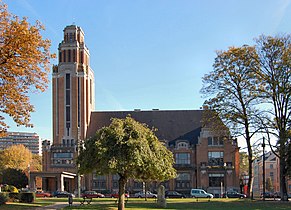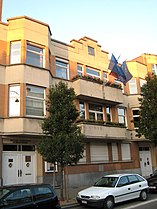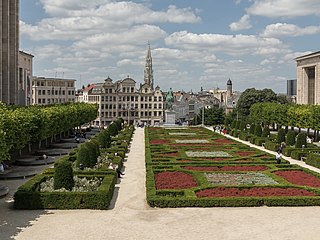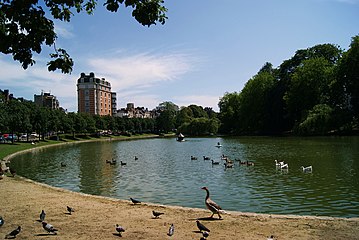
Brussels
Brussels (French: Bruxelles [bʁysɛl] ⓘ or [bʁyksɛl] ⓘ; Dutch: Brussel [ˈbrʏsəl] ⓘ), officially the Brussels-Capital Region[10][11] (French: Région de Bruxelles-Capitale;[a] Dutch: Brussels Hoofdstedelijk Gewest),[b] is a region of Belgium comprising 19 municipalities, including the City of Brussels, which is the capital of Belgium.[12] The Brussels-Capital Region is located in the central portion of the country and is a part of both the French Community of Belgium[13] and the Flemish Community,[14] but is separate from the Flemish Region (within which it forms an enclave) and the Walloon Region, located less than 4 kilometres (2.5 mi) to the south.[15][16] Historically Dutch-speaking, Brussels saw a language shift to French from the late 19th century.[17] Nowadays, the Brussels-Capital Region is officially bilingual in French and Dutch,[18][19] although French is the majority language and lingua franca.[20] Brussels is also increasingly becoming multilingual. English is spoken widely and many migrants and expatriates speak other languages as well.[20][21]
This article is about the Brussels-Capital Region. For the municipality within it, which is the de jure national capital, see City of Brussels. For other places, see Brussels (disambiguation).
Brussels
c. 580
979
c. 870
10 June 1229
18 June 1989
- Anderlecht
- Auderghem / Oudergem
- Berchem-Sainte-Agathe / Sint-Agatha-Berchem
- Bruxelles-Ville / Brussel-Stad
- Etterbeek
- Evere
- Forest / Vorst
- Ganshoren
- Ixelles / Elsene
- Jette
- Koekelberg
- Molenbeek-Saint-Jean / Sint-Jans-Molenbeek
- Saint-Gilles / Sint-Gillis
- Saint-Josse-ten-Noode / Sint-Joost-ten-Node
- Schaerbeek / Schaarbeek
- Uccle / Ukkel
- Watermael-Boitsfort / Watermaal-Bosvoorde
- Woluwe-Saint-Lambert / Sint-Lambrechts-Woluwe
- Woluwe-Saint-Pierre / Sint-Pieters-Woluwe
Rudi Vervoort (PS)
Rachid Madrane (PS)
162.4 km2 (62.7 sq mi)
13 m (43 ft)
1,235,192
1,212,352
7,600/km2 (20,000/sq mi)
2,500,000
€96.513 billion (2022)[7]
€200.457 billion (2022)
02
BE-BRU
Brussels grew from a small rural settlement on the river Senne to become an important city-region in Europe. Since the end of the Second World War, it has been a major centre for international politics and home to numerous international organisations, politicians, diplomats and civil servants.[22] Brussels is the de facto capital of the European Union, as it hosts a number of principal EU institutions, including its administrative-legislative, executive-political, and legislative branches (though the judicial branch is located in Luxembourg, and the European Parliament meets for a minority of the year in Strasbourg).[23][24][c] Because of this, its name is sometimes used metonymically to describe the EU and its institutions.[25][26] The secretariat of the Benelux and the headquarters of NATO are also located in Brussels.[27][28]
Brussels is the most densely populated region in Belgium, and although it has the highest GDP per capita,[29] it has the lowest available income per household.[30] The Brussels Region covers 162 km2 (63 sq mi) and has a population of over 1.2 million.[31] Its five times larger metropolitan area comprises over 2.5 million people, which makes it the largest in Belgium.[32][33][34] It is also part of a large conurbation extending towards the cities of Ghent, Antwerp, and Leuven, known as the Flemish Diamond, as well as the province of Walloon Brabant, in total home to over 5 million people.[35] As Belgium's economic capital and a top financial centre in Western Europe with Euronext Brussels, Brussels is classified as an Alpha global city.[36] It is also a national and international hub for rail, road and air traffic,[37] and is sometimes considered, together with Belgium, as Europe's geographic, economic and cultural crossroads.[38][39][40] The Brussels Metro is the only rapid transit system in Belgium. In addition, both its airport and railway stations are the largest and busiest in the country.[41][42]
Brussels is known for its cuisine and gastronomic offer (including its local waffle, its chocolate, its French fries and its numerous types of beers),[43] as well as its historical and architectural landmarks; some of them are registered as UNESCO World Heritage Sites.[44] Principal attractions include its historic Grand-Place/Grote Markt (main square), Manneken Pis, the Atomium, and cultural institutions such as La Monnaie/De Munt and the Museums of Art and History. Due to its long tradition of Belgian comics, Brussels is also hailed as a capital of the comic strip.[1][45]
The 19 municipalities (French: communes, Dutch: gemeenten) of the Brussels-Capital Region are political subdivisions with individual responsibilities for the handling of local level duties, such as law enforcement and the upkeep of schools and roads within its borders.[108][109] Municipal administration is also conducted by a mayor, a council, and an executive.[109]
In 1831, Belgium was divided into 2,739 municipalities, including the 19 in the Brussels-Capital Region.[110] Unlike most of the municipalities in Belgium, the ones located in the Brussels-Capital Region were not merged with others during mergers occurring in 1964, 1970, and 1975.[110] However, several municipalities outside the Brussels-Capital Region have been merged with the City of Brussels throughout its history, including Laeken, Haren and Neder-Over-Heembeek in 1921.[111]
The largest municipality in area and population is the City of Brussels, covering 32.6 km2 (12.6 sq mi) and with 145,917 inhabitants; the least populous is Koekelberg with 18,541 inhabitants. The smallest in area is Saint-Josse-ten-Noode, which is only 1.1 km2 (0.4 sq mi), but still has the highest population density in the region, with 20,822/km2 (53,930/sq mi). Watermael-Boitsfort has the lowest population density in the region, with 1,928/km2 (4,990/sq mi).
There is much controversy on the division of 19 municipalities for a highly urbanised region, which is considered as (half of) one city by most people. Some politicians mock the "19 baronies" and want to merge the municipalities under one city council and one mayor.[112][113] That would lower the number of politicians needed to govern Brussels, and centralise the power over the city to make decisions easier, thus reduce the overall running costs. The current municipalities could be transformed into districts with limited responsibilities, similar to the current structure of Antwerp or to structures of other capitals like the boroughs in London or arrondissements in Paris, to keep politics close enough to the citizen.[114]
In early 2016, Molenbeek-Saint-Jean held a reputation as a safe haven for jihadists in relation to the support shown by some residents towards the bombers who carried out the Paris and Brussels attacks.[115][116][117][118][119]
The architecture in Brussels is diverse, and spans from the clashing combination of Gothic, Baroque, and Louis XIV styles on the Grand-Place to the postmodern buildings of the EU institutions.[206]
Very little medieval architecture is preserved in Brussels. Buildings from that period are mostly found in the historical centre (called Îlot Sacré), Saint Géry/Sint-Goriks and Sainte-Catherine/Sint Katelijne neighbourhoods. The Brabantine Gothic Cathedral of St. Michael and St. Gudula remains a prominent feature in the skyline of downtown Brussels. Isolated portions of the first city walls were saved from destruction and can be seen to this day. One of the only remains of the second walls is the Halle Gate. The Grand-Place is the main attraction in the city centre and has been a UNESCO World Heritage Site since 1998.[207] The square is dominated by the 15th century Flamboyant Town Hall, the neo-Gothic Breadhouse and the Baroque guildhalls of the former Guilds of Brussels. Manneken Pis, a fountain containing a small bronze sculpture of a urinating youth, is a tourist attraction and symbol of the city.[208]
The neoclassical style of the 18th and 19th centuries is represented in the Royal Quarter/Coudenberg area, around Brussels Park and the Place Royale/Koningsplein. Examples include the Royal Palace, the Church of St. James on Coudenberg, the Palace of the Nation (Parliament building), the Academy Palace, the Palace of Charles of Lorraine, the Palace of the Count of Flanders and the Egmont Palace. Other uniform neoclassical ensembles can be found around the Place des Martyrs/Martelaarsplein and the Place de Barricades/Barricadenplein. Some additional landmarks in the centre are the Royal Saint-Hubert Galleries (1847), one of the oldest covered shopping arcades in Europe, the Congress Column (1859), the former Brussels Stock Exchange building (1873) and the Palace of Justice (1883). The latter, designed by Joseph Poelaert, in eclectic style, is reputed to be the largest building constructed in the 19th century.[209]
Located outside the historical centre, in a greener environment bordering the European Quarter, are the Parc du Cinquantenaire/Jubelpark with its memorial arcade and nearby museums, and in Laeken, the Royal Palace of Laeken and the Royal Domain with its large greenhouses, as well as the Museums of the Far East.
Also particularly striking are the buildings in the Art Nouveau style, most famously by the Belgian architects Victor Horta, Paul Hankar and Henry Van de Velde.[210][211] Some of Brussels' municipalities, such as Schaerbeek, Etterbeek, Ixelles, and Saint-Gilles, were developed during the heyday of Art Nouveau and have many buildings in that style. The Major Town Houses of the Architect Victor Horta—Hôtel Tassel (1893), Hôtel van Eetvelde (1898), Hôtel Solvay (1900) and the Horta Museum (1901)—have been listed as a UNESCO World Heritage Site since 2000.[83] Another example of Brussels' Art Nouveau is the Stoclet Palace (1911), by the Viennese architect Josef Hoffmann, designated a World Heritage Site by UNESCO in June 2009.[212]
Art Deco structures in Brussels include the Résidence Palace (1927) (now part of the Europa building), the Centre for Fine Arts (1928), the Villa Empain (1934), the Town Hall of Forest (1938), and the Flagey Building (formerly known as the Maison de la Radio) on the Place Eugène Flagey/Eugène Flageyplein (1938) in Ixelles. Some religious buildings from the interwar era were also constructed in that style, such as the Church of St. John the Baptist (1932) in Molenbeek and the Church of St. Augustine (1935) in Forest. Completed only in 1969, and combining Art Deco with neo-Byzantine elements, the Basilica of the Sacred Heart in Koekelberg is one of the largest churches by area in the world, and its cupola provides a panoramic view of Brussels and its outskirts. Another example are the exhibition halls of the Centenary Palace, built for the 1935 World's Fair on the Heysel/Heizel Plateau in northern Brussels, home to the Brussels Exhibition Centre (Brussels Expo).[213]
The Atomium is a symbolic 103 m-tall (338 ft) modernist structure, located on the Heysel Plateau, which was originally built for the 1958 World's Fair (Expo 58). It consists of nine steel spheres connected by tubes, and forms a model of an iron crystal (specifically, a unit cell), magnified 165 billion times. The architect André Waterkeyn devoted the building to science. It is now considered a landmark of Brussels.[214][215] Next to the Atomium, is Mini-Europe miniature park, with 1:25 scale maquettes of famous buildings from across Europe.
Since the second half of the 20th century, modern office towers have been built in Brussels (Madou Tower, Rogier Tower, Proximus Towers, Finance Tower, the World Trade Center, among others). There are some thirty towers, mostly concentrated in the city's main business district: the Northern Quarter (also called Little Manhattan), near Brussels-North railway station. The South Tower, standing adjacent to Brussels-South railway station, is the tallest building in Belgium, at 148 m (486 ft). Along the North–South connection, is the State Administrative City, an administrative complex in the International Style. The postmodern buildings of the Espace Léopold complete the picture.
The city's embrace of modern architecture translated into an ambivalent approach towards historic preservation, leading to the destruction of notable architectural landmarks, most famously the Maison du Peuple/Volkshuis by Victor Horta, a process known as Brusselisation.[86][87]
Brussels is one of the greenest capitals in Europe, with over 8,000 hectares of green spaces.[320] Vegetation cover and natural areas are higher in the outskirts, where they have limited the peri-urbanisation of the capital, but they decrease sharply towards the centre of Brussels; 10% in the central Pentagon, 30% of the municipalities in the first ring, and 71% of the municipalities in the second ring are occupied by green spaces.
Many parks and gardens, both public and privately owned, are scattered throughout the city. In addition to this, the Sonian Forest is located in its southern part and stretches out over the three Belgian regions. As of 2017, it has been inscribed as a UNESCO World Heritage Site, the only Belgian component to the multinational inscription 'Primeval Beech Forests of the Carpathians and Other Regions of Europe'.[321]

































